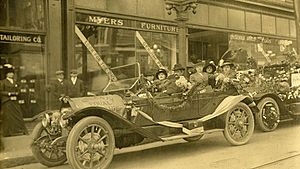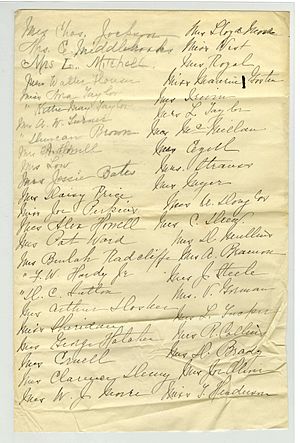Timeline of women's suffrage in Georgia (U.S. state) facts for kids
This is a timeline showing when and how women in Georgia fought for the right to vote. Women's suffrage means women having the right to vote in elections. In Georgia, this movement really began in 1892 with the creation of the Georgia Woman Suffrage Association (GWSA). This group helped bring the first big meeting about women's rights to the Southern United States in 1895. This was when the National American Woman Suffrage Association (NAWSA) held their yearly convention in Atlanta.
The GWSA was the main group working for women's voting rights until 1913. That year, other groups started, like the Georgia Young People's Suffrage Association (GYPSA) and the Georgia Men's League for Woman Suffrage. In 1914, a group called the Georgia Association Opposed to Women's Suffrage (GAOWS) was formed by people who did not want women to vote. Even with all the hard work by suffragists (people who supported women's right to vote) in Georgia, the state often said no to giving women equal voting rights.
In 1917, Waycross, Georgia allowed women to vote in primary elections (early elections to choose candidates). Then, in 1919, Atlanta gave women the same right. Georgia was the first state to say no to the Nineteenth Amendment, which would give women across the country the right to vote. Women in Georgia still had to wait to vote in all state elections even after the Nineteenth Amendment was approved on August 26, 1920. Native American and African American women had to wait even longer to vote. Georgia finally approved the Nineteenth Amendment in 1970.
Contents
The Fight for Women's Vote in the 1800s
Early Efforts in the 1880s
1887
- Georgia passed a "cumulative" poll tax. This meant people had to pay all their past taxes to vote. This made it harder for many people, especially poor people, to vote.
Growing Support in the 1890s
1890
- Helen Augusta Howard started a small group for women's suffrage. This was the first one in Georgia. It later became the Georgia Woman Suffrage Association (GWSA).
1894
- The Equal Suffrage League of Atlanta was formed. It was a local part of the GWSA.
1895
- January: The National American Woman Suffrage Association (NAWSA) held its yearly meeting in Atlanta. This was a big event for the South.
- February 4: Susan B. Anthony, a famous leader for women's rights, spoke at Atlanta University.
- The Sunny South newspaper from Atlanta said it supported women's right to vote.
1896
- Mary Latimer McLendon started the Atlanta part of the GWSA.
1899
- November: The GWSA held its first big meeting in Atlanta.
The 20th Century and Women's Suffrage
Early 1900s Efforts
1900
- The Georgia Federation of Labor, a group for workers, supported women's right to vote.
- Georgia created white primaries. These were elections where only white people could vote.
1901
- November: The GWSA held its yearly meeting.
1902
- Women in Atlanta asked the local government if they could vote in city elections. Their request was turned down.
- November: The GWSA held its yearly meeting in Atlanta at the Universalist Church.
1903
- The GWSA held its state meeting. Kate M. Gordon was a speaker there.
1905
- McLendon from the GWSA talked to the Georgia part of the Woman's Christian Temperance Union (WCTU). The WCTU was a group that worked against alcohol. They were not interested in adding women's suffrage to their goals.
1906
- The state suffrage meeting celebrated the life of Susan B. Anthony.
1907
- The state government passed a law. It said that only men of "good character" could vote. Also, all poll taxes had to be paid six months before an election.
1908
- Mary Latimer McLendon was asked to speak about women's rights at the Georgia Agricultural Association.
- The Georgia Prohibition Party, a political party that wanted to ban alcohol, supported women's right to vote.
1909
- Women in Atlanta again asked the local government for the right to vote in city elections. They were rejected again.
The 1910s: More Groups and Marches
1913
- The Georgia Woman Equal Suffrage League was started.
- The Georgia Young People's Suffrage Association (GYPSA) was formed.
- The Georgia Men's League for Woman Suffrage was also created.
- March 3: Members of GYPSA marched in the big Woman Suffrage Parade in Washington D.C.
- July: The Atlanta Constitution newspaper started a special section about women's suffrage.
- November: The Student's Club of Columbus sponsored a talk by Jean Margaret Gordon.
- December: Suffragists entered three cars in a special "auto floral parade."
1914
- The Equal Suffrage Party of Georgia was organized.
- The Georgia part of the WCTU became more open to women's suffrage at their meeting.
- Spring: The Georgia Association Opposed to Woman Suffrage was formed.
- March: A rally for women's suffrage was held in Atlanta. Jane Addams, a famous social worker, was a main speaker.
- May 2: McLendon spoke on the steps of the State Capitol. Members of GWSA sold copies of the Woman's Journal.
- June 25: Representative Barry Wright introduced a bill for equal suffrage in the Georgia House of Representatives.
- June 30: J. W. Bush introduced a similar bill in the Georgia Senate.
- July: The state suffrage meeting was held at the Hotel Ansley.
- December: Suffragists joined the Advertising Men's Parade. They won three prizes!
1915
- March: The Atlanta Equal Suffrage Association held a program. It included a speech by Rebecca Latimer Felton and a movie called Your Girl and Mine.
- August: The Georgia state government voted against women's suffrage.
- November: The state suffrage meeting was held in Atlanta.
- November: A suffrage parade was held. Eleanor Raoul led the parade on horseback.
- December: A suffrage rally was held in Atlanta with Jean Margaret Gordon speaking.
1916
- Bills for equal suffrage were introduced in both parts of the Georgia government. But they did not pass.
- February: Suffragists got 10,000 people to sign a petition. They asked the Atlanta city council to support women voting in city elections.
- October 28: The Equal Suffrage Party of Georgia held its yearly meeting in Atlanta.
1917
- The Georgia part of the National Woman's Party was formed.
- Waycross, Georgia allowed women to vote in city primary elections.
- July: Women's suffrage was discussed in the Georgia government, but it did not pass.
- November 24: The Equal Suffrage Party of Georgia held its yearly meeting in Augusta.
1919
- January 15: The Equal Suffrage Party of Georgia held its yearly meeting in Savannah.
- May 3: White women in Atlanta gained the right to vote in city primary elections.
The 1920s: A New Era
1920
- March: The Equal Suffrage Party of Georgia closed down. It then formed the League of Women Voters (LWV) of Georgia.
- July 24: Georgia was the first state to reject the Nineteenth Amendment. This amendment would give women across the country the right to vote.
- September 8: McLendon and other women tried to vote and register to vote, but they were turned away.
1921
- The Georgia government passed a law. It allowed women to vote and hold public office.
1922
- White women in Georgia were able to vote in all state elections.
1924
- Native American women were given citizenship. This meant they could vote.
Later Milestones: 1950s to 1970s
1956
- The Georgia LWV changed its rules. It now allowed people of any race to join.
1965
- The Voting Rights Act of 1965 was passed. This law removed rules that stopped Black women from voting.
1970
- February 20: Georgia finally approved the Nineteenth Amendment.



